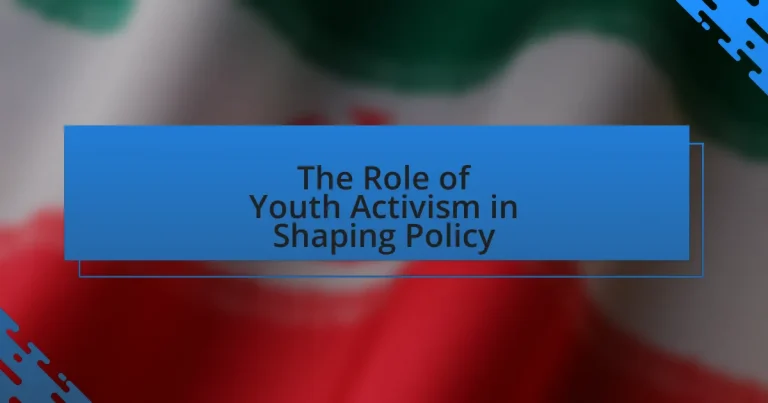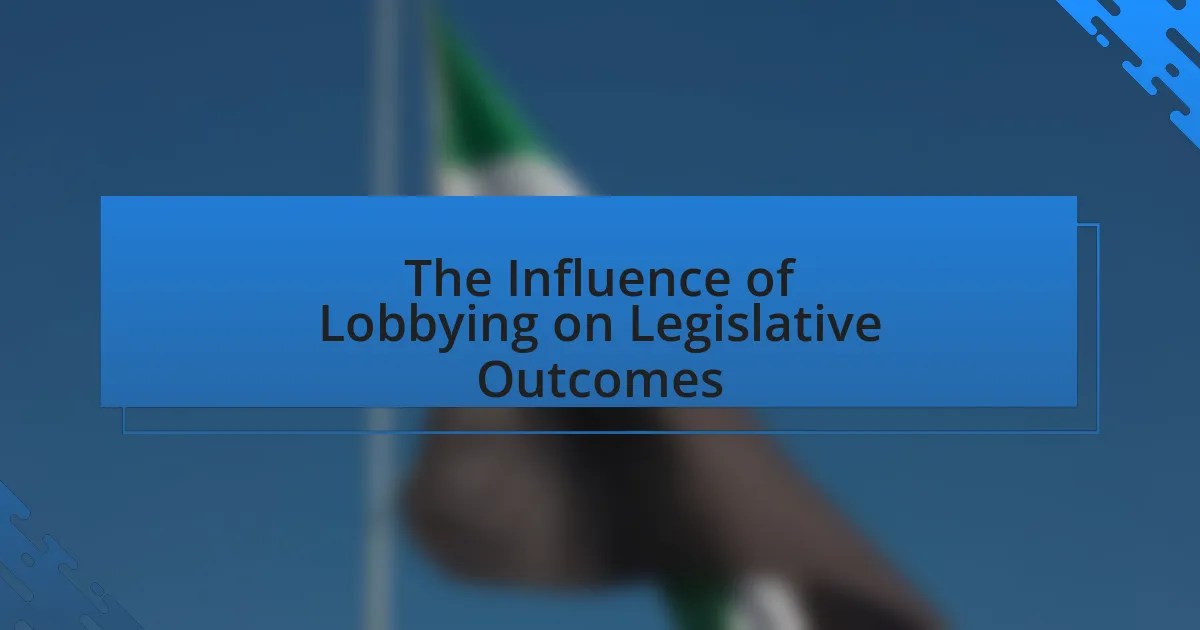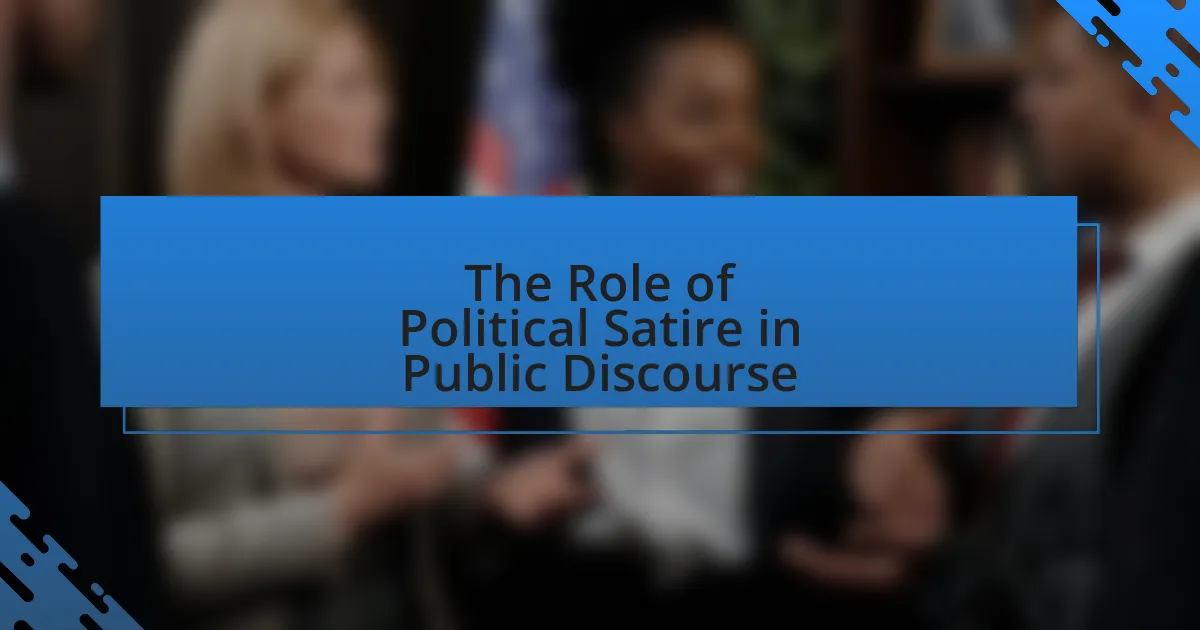Youth activism plays a vital role in shaping policy by mobilizing young individuals to advocate for social, environmental, and political change. This article explores the historical influence of youth activism on policy changes, highlighting key movements such as the Civil Rights Movement, climate strikes, and gun control initiatives. It examines the unique perspectives young activists bring to policy discussions, the challenges they face, and the strategies they employ to effectively influence decision-makers. Additionally, the article discusses current trends in youth activism, the importance of education and mentorship, and practical steps young people can take to engage in policy advocacy.
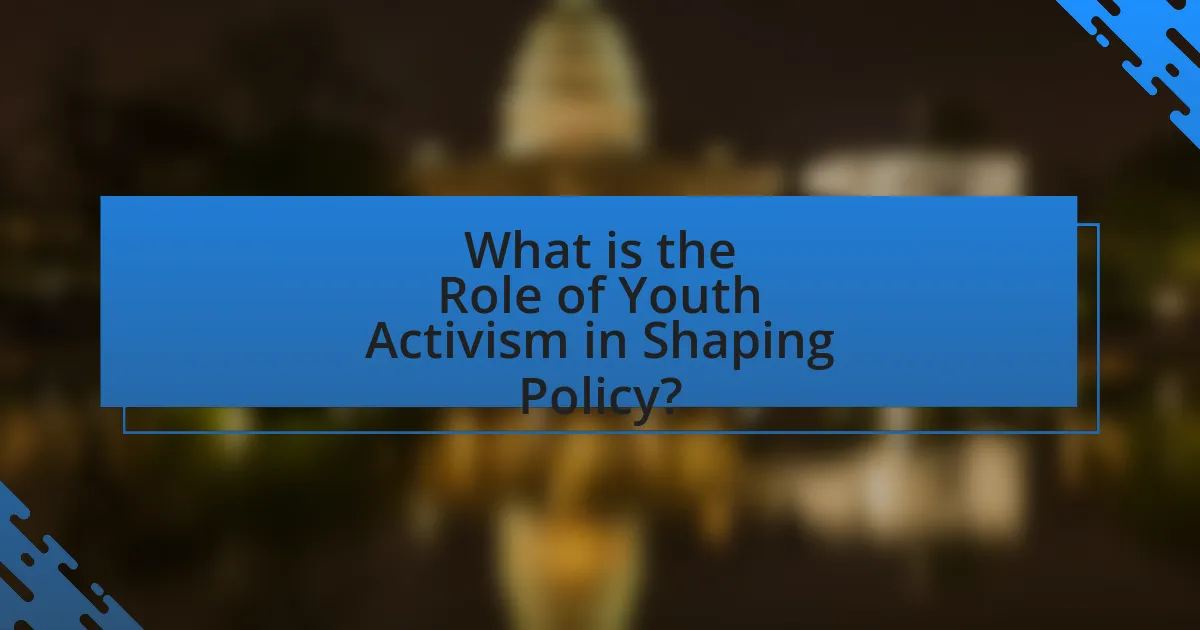
What is the Role of Youth Activism in Shaping Policy?
Youth activism plays a crucial role in shaping policy by mobilizing young people to advocate for social, environmental, and political change. This activism influences decision-makers through organized campaigns, protests, and social media engagement, effectively raising awareness and pushing for legislative reforms. For instance, the global climate strikes initiated by youth activists like Greta Thunberg have significantly impacted climate policy discussions, leading to commitments from governments to address climate change more aggressively. Additionally, studies show that youth-led movements can sway public opinion and increase voter turnout, further amplifying their influence on policy outcomes.
How has youth activism historically influenced policy changes?
Youth activism has historically influenced policy changes by mobilizing young people to advocate for social, political, and environmental reforms, leading to significant legislative outcomes. For instance, the Civil Rights Movement in the 1960s saw youth-led initiatives, such as the Student Nonviolent Coordinating Committee, which played a crucial role in the passage of the Civil Rights Act of 1964 and the Voting Rights Act of 1965. Similarly, the anti-Vietnam War protests in the late 1960s, driven largely by college students, contributed to a shift in public opinion and ultimately influenced U.S. foreign policy decisions. More recently, the March for Our Lives movement, initiated by students after the Parkland shooting in 2018, has pushed for gun control legislation, demonstrating the ongoing impact of youth activism on policy. These examples illustrate how organized youth efforts can lead to tangible changes in laws and regulations, reflecting their power in shaping policy.
What key events highlight the impact of youth activism on policy?
Key events that highlight the impact of youth activism on policy include the March for Our Lives in 2018, which advocated for gun control following the Parkland shooting, leading to legislative discussions on gun reform in several states. Another significant event is the global climate strikes initiated by Greta Thunberg, which mobilized millions of young people and influenced the United Nations Climate Action Summit in 2019, prompting countries to commit to more aggressive climate policies. Additionally, the Black Lives Matter protests in 2020, driven by youth activism, resulted in renewed discussions on police reform and racial justice legislation across the United States. These events demonstrate how organized youth movements can effectively shape public policy and influence legislative agendas.
How have different movements shaped public policy over time?
Different movements have significantly shaped public policy over time by advocating for social change and influencing legislative agendas. For instance, the Civil Rights Movement in the 1960s led to landmark legislation such as the Civil Rights Act of 1964 and the Voting Rights Act of 1965, which aimed to eliminate racial discrimination and ensure voting rights for African Americans. Similarly, the environmental movement has resulted in policies like the Clean Air Act and the Clean Water Act, which were enacted to address pollution and protect natural resources. These movements mobilized public opinion, engaged citizens, and pressured lawmakers, demonstrating the power of collective action in shaping policy outcomes.
Why is youth activism important in contemporary society?
Youth activism is important in contemporary society because it empowers young individuals to influence social and political change. This demographic often brings fresh perspectives and innovative solutions to pressing issues such as climate change, racial equality, and education reform. For instance, the global climate strikes initiated by youth activists like Greta Thunberg mobilized millions and significantly raised awareness about environmental issues, leading to policy discussions at international levels. Furthermore, studies show that youth engagement in activism correlates with increased civic participation, fostering a generation that is more informed and active in democratic processes.
What unique perspectives do young activists bring to policy discussions?
Young activists bring fresh, innovative perspectives to policy discussions by prioritizing issues such as climate change, social justice, and equity, which are often overlooked by traditional policymakers. Their unique viewpoints stem from a deep understanding of the challenges faced by their generation, including economic instability and environmental degradation. For instance, studies show that youth-led movements, like the global climate strikes initiated by Greta Thunberg, have significantly influenced public discourse and policy agendas, leading to increased urgency in addressing climate policies. This generational lens allows young activists to advocate for solutions that are not only sustainable but also inclusive, reflecting the diverse needs of their communities.
How does youth activism address issues that affect younger generations?
Youth activism addresses issues affecting younger generations by mobilizing collective action to advocate for policy changes that directly impact their lives. This activism often focuses on critical areas such as climate change, education reform, and social justice, where young people are disproportionately affected. For instance, the global climate strikes initiated by youth activists like Greta Thunberg have raised awareness about environmental policies, leading to increased public discourse and legislative proposals aimed at sustainability. Additionally, organizations like March for Our Lives have highlighted gun violence, pushing for stricter gun control measures in response to school shootings, which predominantly affect students. These movements demonstrate how youth activism not only amplifies the voices of younger generations but also influences policymakers to prioritize their concerns in legislative agendas.
What challenges do youth activists face in shaping policy?
Youth activists face significant challenges in shaping policy, primarily due to systemic barriers, lack of access to decision-making processes, and limited resources. Systemic barriers include age-related biases that often lead to the dismissal of their perspectives as inexperienced or naive. Additionally, youth activists frequently encounter obstacles in accessing political platforms where policy discussions occur, as these spaces are often dominated by established adults and institutions. Limited financial resources hinder their ability to mobilize effectively, conduct research, and engage in advocacy campaigns. According to a 2021 report by the United Nations, youth-led movements often struggle to secure funding, which is crucial for sustaining their initiatives and amplifying their voices in policy debates.
How do systemic barriers hinder youth participation in policy-making?
Systemic barriers hinder youth participation in policy-making by creating obstacles such as lack of access to information, limited representation, and institutional biases. These barriers manifest in various forms, including age-related discrimination, inadequate outreach efforts to engage young people, and the prioritization of established voices over emerging ones. For instance, a study by the United Nations in 2018 highlighted that only 1% of youth feel their voices are adequately represented in political processes, indicating a significant disconnect between youth and decision-makers. This lack of representation and engagement leads to policies that do not reflect the needs and perspectives of younger generations, further entrenching their exclusion from meaningful participation in shaping policy.
What role does social media play in overcoming these challenges?
Social media serves as a crucial tool for youth activism by amplifying voices, mobilizing support, and facilitating communication. It enables young activists to share information rapidly, organize events, and raise awareness about specific issues, thereby overcoming barriers such as geographical limitations and traditional media gatekeeping. For instance, movements like #FridaysForFuture have utilized platforms like Twitter and Instagram to coordinate global climate strikes, demonstrating the effectiveness of social media in uniting diverse groups around a common cause. This connectivity fosters a sense of community and urgency, empowering youth to influence policy discussions and advocate for change effectively.
How can youth activism effectively influence policy outcomes?
Youth activism can effectively influence policy outcomes by mobilizing public opinion and leveraging social media to amplify their messages. For instance, the global climate strikes led by youth activists like Greta Thunberg have raised awareness and pressured governments to adopt more aggressive climate policies. Research from the Pew Research Center indicates that young people are more likely to engage in activism and express their views on social media, which can lead to increased visibility and support for specific policy changes. Additionally, youth-led organizations often engage in lobbying efforts, directly communicating with policymakers to advocate for their causes, as seen in movements advocating for gun control and racial justice.
What strategies have proven successful for youth activists?
Successful strategies for youth activists include grassroots organizing, leveraging social media, and forming coalitions with established organizations. Grassroots organizing enables youth to mobilize their communities effectively, as seen in movements like the March for Our Lives, which successfully advocated for gun control reforms. Leveraging social media allows activists to reach a broader audience quickly; for instance, the #FridaysForFuture movement, initiated by Greta Thunberg, gained global traction and influenced climate policy discussions. Forming coalitions with established organizations enhances credibility and resource access, exemplified by youth-led groups partnering with larger environmental NGOs to amplify their impact on climate legislation. These strategies have consistently demonstrated effectiveness in shaping policy outcomes.
How can collaboration with established organizations enhance youth activism?
Collaboration with established organizations enhances youth activism by providing access to resources, networks, and expertise that amplify the impact of youth-led initiatives. Established organizations often have established credibility, which can lend legitimacy to youth movements, attracting more attention and support. For instance, partnerships with organizations like Amnesty International or Greenpeace can offer youth activists training, funding, and platforms to reach wider audiences. Research shows that youth-led campaigns that collaborate with established entities are more likely to achieve policy changes, as evidenced by the success of the March for Our Lives movement, which gained significant traction through partnerships with established advocacy groups.
What role does grassroots organizing play in policy advocacy?
Grassroots organizing plays a crucial role in policy advocacy by mobilizing community members to influence decision-makers and promote social change. This form of organizing empowers individuals to collectively voice their concerns, thereby increasing public awareness and pressure on policymakers. For instance, movements like the Fight for $15 have successfully advocated for minimum wage increases across various states, demonstrating how grassroots efforts can lead to tangible policy outcomes. Additionally, grassroots organizing often fosters a sense of ownership and agency among participants, which can sustain long-term engagement in civic activities and advocacy efforts.
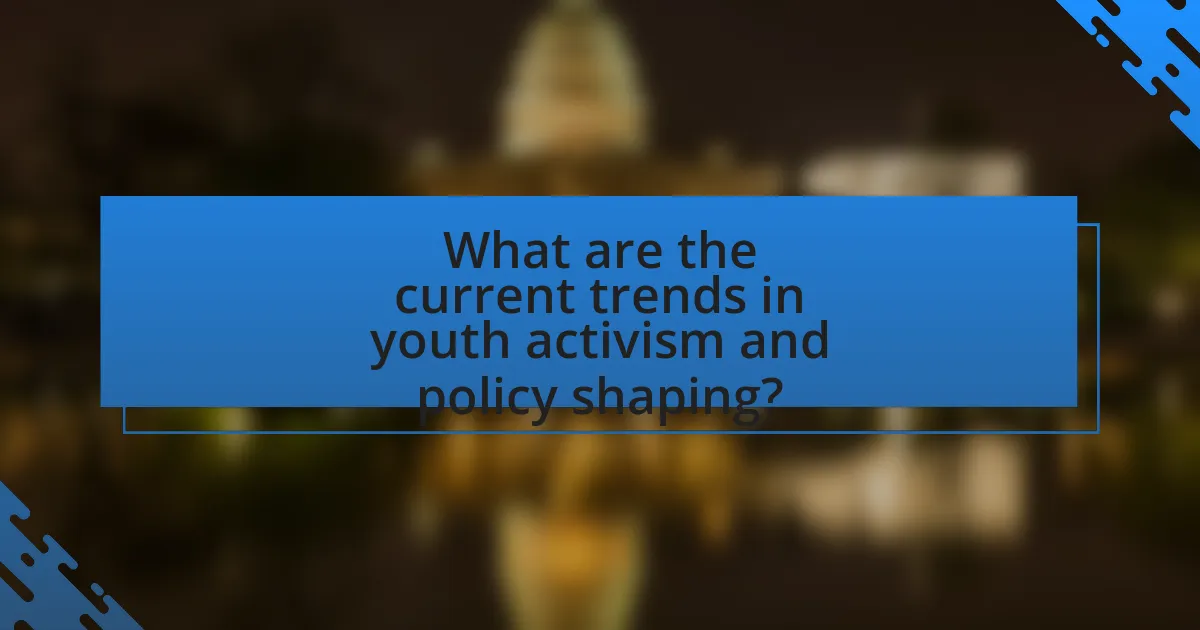
What are the current trends in youth activism and policy shaping?
Current trends in youth activism and policy shaping include increased digital engagement, intersectionality, and climate action. Youth activists are leveraging social media platforms to mobilize support and raise awareness on issues such as racial justice, gender equality, and environmental sustainability. For instance, the global climate strikes led by youth activists like Greta Thunberg have significantly influenced policy discussions on climate change, prompting governments to adopt more ambitious climate goals. Additionally, the rise of intersectional activism highlights the interconnectedness of various social issues, leading to more comprehensive policy proposals that address multiple facets of inequality. These trends demonstrate the growing impact of youth voices in shaping contemporary policy agendas.
How are digital platforms transforming youth activism?
Digital platforms are transforming youth activism by providing accessible tools for organization, communication, and mobilization. These platforms enable young activists to reach a global audience, share information rapidly, and coordinate efforts across geographical boundaries. For instance, social media campaigns like #FridaysForFuture have successfully mobilized millions of young people worldwide to advocate for climate action, demonstrating the power of digital connectivity in amplifying youth voices. Additionally, research from the Pew Research Center indicates that 71% of young people use social media to engage in political discussions, highlighting the significant role these platforms play in shaping public discourse and influencing policy decisions.
What impact does online mobilization have on traditional policy advocacy?
Online mobilization significantly enhances traditional policy advocacy by increasing engagement and expanding reach. Digital platforms allow advocates to connect with a broader audience, facilitating rapid dissemination of information and mobilization of supporters. For instance, the 2017 Women’s March utilized social media to organize millions of participants globally, demonstrating how online tools can amplify grassroots movements and influence policy discussions. This shift has led to a more inclusive dialogue, where diverse voices can contribute to advocacy efforts, ultimately shaping policy outcomes more effectively.
How do virtual campaigns engage a broader audience?
Virtual campaigns engage a broader audience by leveraging digital platforms to reach diverse demographics across geographical boundaries. These campaigns utilize social media, email, and online events to disseminate information quickly and interactively, allowing for real-time engagement and feedback. For instance, a study by the Pew Research Center found that 69% of adults in the U.S. use social media, which provides a vast network for campaigns to connect with individuals who may not participate in traditional activism. Additionally, virtual campaigns often employ targeted advertising and analytics to tailor messages to specific audience segments, enhancing relevance and engagement.
What issues are currently driving youth activism?
Climate change is currently the primary issue driving youth activism. Young activists are increasingly mobilizing around the urgent need for environmental action, as evidenced by global movements like Fridays for Future, initiated by Greta Thunberg, which has inspired millions to demand policy changes from governments. Additionally, social justice issues, including racial equality and gender rights, are significant motivators, highlighted by movements such as Black Lives Matter, which has seen substantial youth participation advocating for systemic reforms. Economic inequality and access to education also fuel activism, with youth calling for equitable policies that address these disparities. These issues are interconnected, reflecting a broader demand for a sustainable and just future.
How do climate change and social justice intersect in youth-led movements?
Climate change and social justice intersect in youth-led movements through the recognition that marginalized communities disproportionately suffer from environmental degradation and climate impacts. Youth activists advocate for equitable climate policies that address these disparities, emphasizing that social justice is integral to effective climate action. For instance, movements like Fridays for Future highlight how low-income and minority populations often face greater risks from climate change, such as extreme weather events and pollution. This intersection is further evidenced by the United Nations’ acknowledgment that climate change exacerbates existing inequalities, prompting youth to demand systemic changes that prioritize both environmental sustainability and social equity.
What role does education reform play in youth activism today?
Education reform plays a crucial role in youth activism today by empowering young individuals to advocate for systemic changes that address inequities in the educational system. This empowerment is evident as youth activists mobilize around issues such as access to quality education, curriculum inclusivity, and the need for mental health resources in schools. For instance, the 2018 March for Our Lives movement, initiated by students in response to gun violence, highlighted the importance of educational environments that support student safety and well-being. Furthermore, research from the National Youth Rights Association indicates that youth-led initiatives have successfully influenced local and national policies, demonstrating the significant impact of education reform on fostering civic engagement among young people.
How can youth activists measure their impact on policy?
Youth activists can measure their impact on policy by analyzing changes in legislation, public opinion, and engagement metrics related to their campaigns. For instance, tracking the introduction of bills influenced by their advocacy efforts or monitoring shifts in voter sentiment through surveys can provide concrete evidence of their effectiveness. Additionally, evaluating participation rates in events and social media engagement can quantify their reach and influence, demonstrating how their actions resonate with the public and policymakers.
What metrics are useful for assessing the effectiveness of youth-led initiatives?
Useful metrics for assessing the effectiveness of youth-led initiatives include participation rates, engagement levels, and impact assessments. Participation rates measure the number of youth involved in initiatives, indicating the initiative’s reach and appeal. Engagement levels assess the quality of involvement, such as the frequency of participation and the depth of interaction among participants. Impact assessments evaluate the outcomes of initiatives, including changes in policy, community awareness, or behavioral shifts, providing concrete evidence of effectiveness. For instance, a study by the National Youth Leadership Council found that youth-led initiatives that tracked these metrics demonstrated a 30% increase in community engagement and policy influence over a two-year period.
How can feedback from policymakers inform future activism efforts?
Feedback from policymakers can inform future activism efforts by providing insights into the effectiveness of current strategies and highlighting areas for improvement. When activists receive specific feedback on their proposals or campaigns, they can adjust their messaging, tactics, and goals to better align with the political landscape and the interests of decision-makers. For instance, if policymakers indicate that a particular issue lacks public support, activists can focus on raising awareness and building community engagement around that topic. Additionally, feedback can reveal the feasibility of proposed solutions, allowing activists to refine their approaches based on practical considerations. This iterative process enhances the likelihood of successful advocacy, as evidenced by the increased effectiveness of youth-led movements that adapt their strategies based on governmental responses, such as the climate strikes led by youth activists which evolved in response to policy discussions and public sentiment.
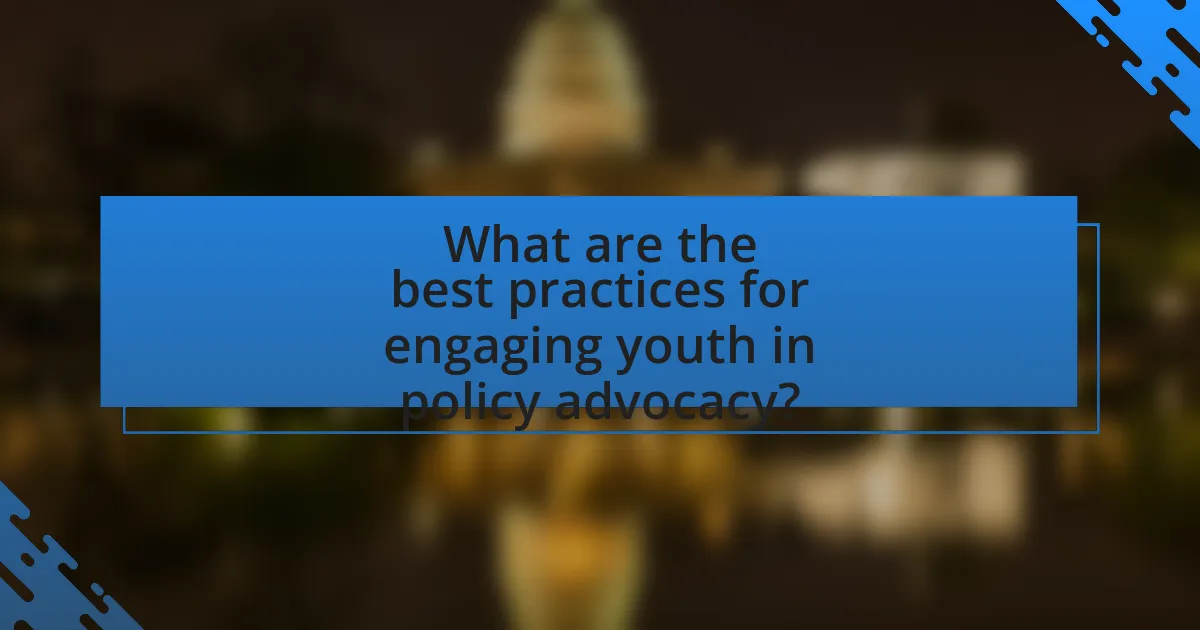
What are the best practices for engaging youth in policy advocacy?
The best practices for engaging youth in policy advocacy include fostering inclusive participation, providing education on policy processes, and utilizing digital platforms for outreach. Inclusive participation ensures that diverse youth voices are heard, which enhances the legitimacy and effectiveness of advocacy efforts. Education on policy processes equips youth with the knowledge needed to navigate and influence decision-making, as evidenced by programs like the Youth Leadership Council, which has successfully trained over 1,000 young advocates in various regions. Utilizing digital platforms, such as social media, allows for broader engagement and mobilization, as seen in campaigns like the March for Our Lives, which effectively reached millions of young people and influenced gun control discussions. These practices collectively empower youth to actively shape policies that affect their lives.
How can organizations support youth activists in their efforts?
Organizations can support youth activists by providing resources, mentorship, and platforms for their voices. By offering financial support, organizations can enable youth to access training, materials, and opportunities for advocacy. Mentorship programs can connect young activists with experienced leaders, enhancing their skills and confidence. Additionally, creating platforms for youth to share their ideas and initiatives, such as social media campaigns or community events, amplifies their impact. Research shows that youth-led movements, such as the March for Our Lives, have successfully influenced policy changes, demonstrating the effectiveness of organizational support in empowering young activists.
What resources are essential for empowering young activists?
Essential resources for empowering young activists include access to education, funding, mentorship, and digital tools. Education equips young activists with knowledge about social issues, policy-making, and advocacy strategies, which is crucial for effective activism. Funding provides the necessary financial support for initiatives, campaigns, and events, enabling activists to mobilize and implement their ideas. Mentorship from experienced activists or professionals offers guidance, networking opportunities, and skill development, fostering growth and resilience in young leaders. Digital tools, such as social media platforms and online collaboration software, facilitate communication, organization, and outreach, allowing young activists to amplify their voices and connect with broader audiences. Collectively, these resources enhance the capacity of young activists to influence policy and drive social change.
How can mentorship programs enhance youth involvement in policy-making?
Mentorship programs can enhance youth involvement in policy-making by providing guidance, resources, and networking opportunities that empower young individuals to engage effectively in the political process. These programs connect youth with experienced mentors who can share insights on navigating policy frameworks, understanding legislative processes, and developing advocacy skills. Research indicates that youth who participate in mentorship programs are more likely to engage in civic activities, with studies showing a 30% increase in political participation among mentored youth compared to their peers. This increased involvement is crucial for fostering a generation of informed and active citizens capable of influencing policy decisions.
What role does education play in fostering youth activism?
Education plays a crucial role in fostering youth activism by equipping young individuals with the knowledge, skills, and critical thinking necessary to engage in social and political issues. Through formal education, students learn about civic rights, social justice, and the mechanisms of government, which empowers them to advocate for change. Research indicates that educational programs that include service learning and civic engagement components significantly increase students’ likelihood of participating in activism. For instance, a study by the Center for Information and Research on Civic Learning and Engagement found that high school students who participated in civic education were more likely to vote and engage in community service as young adults. This demonstrates that education not only informs youth about societal issues but also inspires them to take action, thereby shaping policy through active participation.
How can schools integrate activism into their curricula?
Schools can integrate activism into their curricula by incorporating project-based learning that focuses on social issues, allowing students to engage in community service projects, and facilitating discussions on current events and civic responsibilities. This approach not only enhances critical thinking and problem-solving skills but also empowers students to understand and influence the world around them. Research indicates that students involved in activism-related projects demonstrate increased civic engagement and awareness, as evidenced by a study published in the Journal of Educational Psychology, which found that active participation in social issues leads to higher levels of political participation in adulthood.
What skills are crucial for effective youth advocacy?
Effective youth advocacy requires strong communication skills, critical thinking, and the ability to mobilize and engage others. Communication skills enable advocates to articulate their messages clearly and persuasively, which is essential for influencing policymakers and raising awareness. Critical thinking allows youth advocates to analyze issues, develop informed positions, and create strategic plans for action. Additionally, the ability to mobilize and engage peers fosters a sense of community and collective action, which is vital for driving change. These skills are supported by research indicating that effective advocacy campaigns often hinge on clear messaging and community involvement, as seen in successful youth-led initiatives that have influenced policy changes.
What practical steps can young people take to influence policy?
Young people can influence policy by engaging in grassroots activism, participating in local government meetings, and utilizing social media platforms to raise awareness. Grassroots activism allows youth to mobilize their communities around specific issues, as seen in movements like March for Our Lives, which effectively advocated for gun control reforms. Attending local government meetings provides young individuals with the opportunity to voice their concerns directly to policymakers, fostering dialogue and accountability. Additionally, social media serves as a powerful tool for young people to amplify their messages, organize campaigns, and connect with like-minded individuals, as demonstrated by the global reach of climate strikes initiated by youth activists. These steps collectively empower young people to shape policy discussions and drive change.
